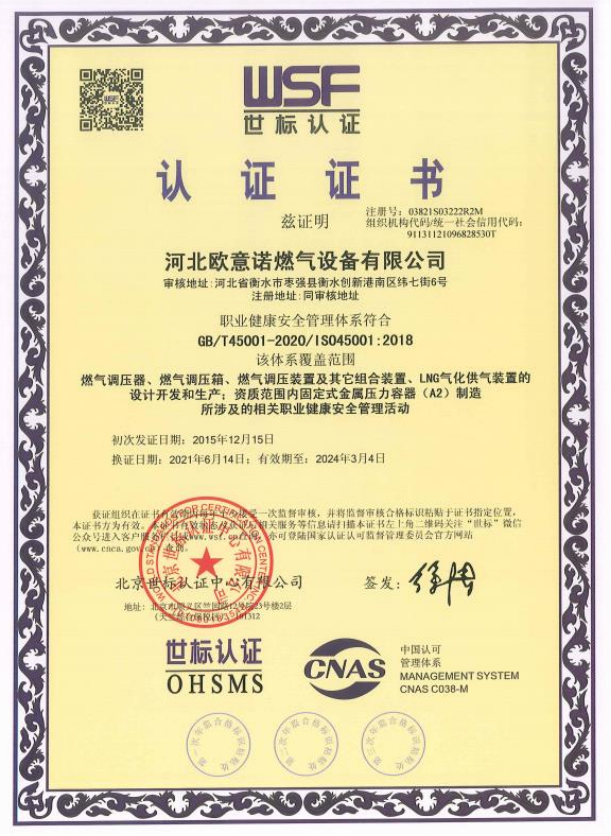
Nov . 23, 2024 14:56
Back to list
Pressure Regulation Techniques for Enhanced System Performance and Stability
Understanding the Role of Pressure Regulators in Fluid Systems
In various industrial applications, the management of pressure within fluid systems is crucial for maintaining safety and efficiency. Pressure regulators, commonly referred to as pressure control devices, play a vital role in this process. These devices ensure that the pressure within a system remains within desired limits, preventing potential hazards such as leaks, equipment failure, and operational inefficiencies. This article will delve into the significance, functionality, and applications of pressure regulators in fluid systems.
What is a Pressure Regulator?
A pressure regulator is a mechanical device designed to maintain a steady output pressure regardless of changes in inlet pressure or flow demand. Typically used in gas and liquid applications, these devices help to modulate pressure to optimal levels for various processes. Pressure regulators can be found in a wide range of industries, including oil and gas, chemical manufacturing, and even in household applications such as water supply systems and gas lines.
How Pressure Regulators Work
The functioning of a pressure regulator is relatively straightforward yet highly efficient. It operates based on the principle of pressure reduction. An inlet pressure is applied to the regulator, and an internal mechanism (usually a diaphragm or piston) responds to the pressure changes. When the inlet pressure exceeds the desired set point, the regulator reduces the output pressure by diverting or venting excess fluid, ensuring that the downstream system receives a steady and safe level of pressure.
Furthermore, pressure regulators can be categorized into two main types adjusting regulators and relief regulators. Adjusting regulators allow the user to set a specific pressure level, while relief regulators automatically vent excess pressure once it exceeds a predetermined limit. This flexibility allows for tailored pressure management suited to specific requirements of different applications.
Importance of Pressure Regulation
.
1. Safety Excessive pressure can lead to catastrophic failures, resulting in injury, fatal accidents, and environmental hazards. By regulating pressure, these devices help mitigate risks associated with system overloads.
مزلقة تنظيم الضغط

2. Efficiency Many processes in fluid systems rely on precise pressure levels to function effectively. For instance, in gas distribution, consistent pressure ensures proper burner operation, leading to efficient fuel consumption.
3. Equipment Longevity Equipment operating under excessive pressure is more prone to wear and tear, resulting in higher maintenance costs and more frequent replacements. Pressure regulators help prolong the lifespan of machinery by ensuring operational pressures are kept within safe limits.
4. Quality Control In processes involving chemical reactions or product manufacturing, controlling pressure can impact product quality. Pressure regulators maintain the necessary conditions, directly influencing the outcome of these processes.
Applications of Pressure Regulators
Pressure regulators find uses in various applications, including but not limited to
- Gas Supply Systems Used to maintain safe and constant pressure levels in domestic and industrial gas supply lines, ensuring that devices such as heaters and stoves operate efficiently. - Water Distribution Ensures that water pressure remains steady across different regions of a municipal supply, aiding in effective distribution and preventing pipe bursts.
- Manufacturing In processes such as painting or coating, pressure regulators ensure that the application equipment maintains consistent pressure for even coating and reduced waste.
- Automotive Systems Utilized in fuel systems to regulate fuel pressure, ensuring optimal engine performance and emission control.
Conclusion
Pressure regulators are essential components in modern fluid systems, providing safety, efficiency, and reliability across numerous applications. By maintaining optimal pressure levels, they not only protect equipment and ensure process effectiveness but also contribute to the overall safety of operations. As industries continue to evolve and integrate more sophisticated technologies, the role of pressure regulators remains indispensable, highlighting the importance of these simple yet crucial devices in our daily lives. Understanding their functions and applications can lead to better design and operational decisions, ultimately promoting safer and more efficient industrial practices.
Next:
Latest news
-
Safety Valve Spring-Loaded Design Overpressure ProtectionNewsJul.25,2025
-
Precision Voltage Regulator AC5 Accuracy Grade PerformanceNewsJul.25,2025
-
Natural Gas Pressure Regulating Skid Industrial Pipeline ApplicationsNewsJul.25,2025
-
Natural Gas Filter Stainless Steel Mesh Element DesignNewsJul.25,2025
-
Gas Pressure Regulator Valve Direct-Acting Spring-Loaded DesignNewsJul.25,2025
-
Decompression Equipment Multi-Stage Heat Exchange System DesignNewsJul.25,2025

